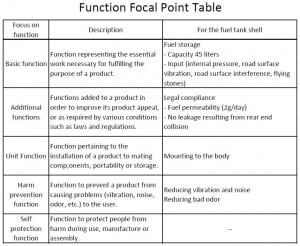The Essence of the Item
What is the essence of properly defined FMEA Functions? More than half of FMEA practitioners miss a key element when defining FMEA functions. This first article in the FMEA Definitions and Concepts Series will discuss functions and their application in FMEAs.
“A perfection of means, and confusion of aims, seems to be our main problem.”
Albert Einstein
Definition of “Function”
The Oxford English dictionary defines “function” as “an activity that is natural to or the purpose of a person or thing.”
What is the definition of “Function” in an FMEA?
A “function” is what the item or process is intended to do, usually to a given standard of performance or requirement. For Design FMEAs, this is the primary purpose or design intent of the item. For Process FMEAs, this is the primary purpose of the manufacturing or assembly operation; wording should consider “Do this [operation] to this [the part] with this [the tooling]” along with any needed requirement. There can be many functions for each item or operation.
How are Functions identified in FMEAs?
The FMEA team reviews relevant documents, as well as considering their engineering experience, to determine the primary functions of the item or process.
For System and Design FMEAs, FMEA Block Diagram, Parameter Diagram (if done), and/or Functional Block Diagram (if done) can be used as input to function descriptions. For Process FMEAs, the Process Flow Diagram and operation work instructions can be used as input to the function descriptions.
Technical Specifications contain product requirements that describe the performance objectives and functions of product designs. Some companies perform an upfront functional decomposition, from system to subsystems to components, which maps to the function column in System or Design FMEAs.
In addition, the FMEA team can be asked questions, such as “what is intended purpose of the item,” or similar questions.
Different types of functions
If you have access to my book Effective FMEAs, chapter 6 includes a listing and description of function categories, which can be useful to ensure no important functions are missed.
In the same chapter, an illustration is included called “Function Focal Point Table” (with permission from Toyota Corporation), which Toyota uses to help ensure all target functions are included in the analysis. Below is an example of a Function Focal Point Table for a fuel tank shell. This is an excellent example of the different types of functions that can be considered in an FMEA. (click to enlarge)
What is an example of a Design FMEA function?
Item: Power steering pump
Function: Delivers hydraulic power for steering by transforming oil pressure at inlet (xx psi) into higher oil pressure at outlet (yy psi) during engine idle speed
Poorly worded example of DFMEA Function: Provides hydraulic power
What is an example of a Process FMEA function?
Process Step: Induction harden shafts using induction hardening machine
Function: Induction harden shafts using induction-hardening machine ABC, with hardness to specification #123, and case depth [xx] inches
Poorly worded example of PFMEA Function: Induction harden the shafts
Application Tip
For Design and Process FMEAs, the function description needs to include the standard of performance or requirements. In my experience, more than half of FMEA practitioners miss this important aspect of function description. Requirements are measurable characteristics of a product function or its operation. A separate column may be included in the FMEA worksheet for requirements, or they can be included in the function description. Functions may have multiple requirements.
Next article:
Each of the articles on FMEA essential elements will be followed by problems and solutions at different levels of experience: beginners, intermediate, and/or advanced. This is a great way to “learn by doing,” and you are invited to participate.

Great article